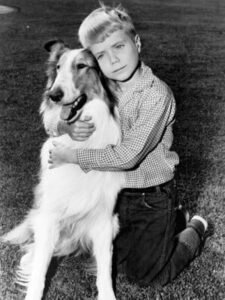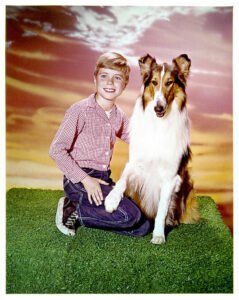For almost twenty years, many of us remember watching the adventures of TV’s most famous dog – Lassie.
This beloved Rough Collie and her human friends were on our screens for 17 seasons, from 1954 to 1973. The show even switched from black and white to color in the 1960s.
But one of the most unforgettable parts of the show was when 7-year-old Timmy Martin joined in the fourth season. Timmy and his family adopted Lassie, creating some of the most memorable moments in the series.

Jon Provost, who played Timmy on *Lassie*, just celebrated his 74th birthday. He looks back fondly on his time filming with his four-legged co-star and remembers how Hollywood discovered him at only 3 years old.
The actor, born in Los Angeles, recalls that when he was 3, his mom took him to an audition for a Jane Wyman movie. She was a huge fan and just wanted her autograph. But out of 200 kids, Jon got the part.
Acting wasn’t something that ran in the family. Jon’s father had a completely different job—he was an aeronautical engineer.
“My parents weren’t Hollywood people,” Jon said. “My father is from Alabama, and my mother is from Texas.”

At age 4, Jon Provost landed a role in a movie with Grace Kelly and Bing Crosby.
“I didn’t have an agent at the time. After that, I got one, and it led to more movies like *The Country Girl* with Bing Crosby and Grace Kelly. I did about 12 movies before I started *Lassie*,” he told Fox News.
Jon also shared memories of working with the three different male dogs who played the role of Lassie. He said he formed a special bond with the last dog who portrayed the famous female collie.

“I did the show for seven years, filming 249 half-hour episodes. I worked with three different Lassies,” Jon Provost told Fox News.
He shared that the last dog he worked with was by his side for five years straight. “We grew up together. For five years, we saw each other five days a week, and sometimes even on weekends.”
Jon also revealed how well-behaved the dog was on set. “The actors made more mistakes than the dog,” he laughed. “They were more of a problem than Lassie.”

After leaving *Lassie* at 14 years old, Jon Provost went on to star with big names like Natalie Wood and Kurt Russell. Despite growing up in Hollywood, he avoided the common pitfalls many child actors face.
“My parents let me pretty much do what I wanted to do. I didn’t have to take a job,” Jon said.
Looking back, he added, “When I left Hollywood, I thought it was good that I did.”

Today, Jon lives away from the spotlight in Northern California but still receives fan mail from his time on *Lassie*. In 1994, he was honored with a star on the Hollywood Walk of Fame.
The character Lassie became so famous that she even had her own radio series.
In 1979, Jon married Sandy Goosens, and they had two children, Ryan and Katie. However, after 14 years of marriage, they divorced in December 1993.
In 1999, Jon found love again when he married Laurie Jacobson, a well-known researcher and author.
I’ve always been a big fan of the adventures this sweet duo went on. And with a moral in every episode, it was the perfect show for kids.
Please share this with all the *Lassie* fans you know.
Minha filha deixou meu neto e desapareceu — três semanas depois, recebi uma ligação que partiu meu coração

Quando minha filha de repente decidiu deixar meu neto para trás por um tempo, achei estranho. O que mais tarde descobri na bolsa da criança deixou meu coração disparado de preocupação. Será que minha filha voltaria para buscar seu filho? Ela estava viva? Continue lendo para saber mais!
A chegada de Jane naquele sábado foi inesperada, mas não incomum. Minha filha sempre foi espontânea. Desta vez, ela apareceu na minha porta com Tommy a tiracolo, seu rosto iluminado com um sorriso cansado que só uma mãe poderia reconhecer. Mas, algo estava diferente.

Uma mulher segura a mão do filho com a bolsa dele atrás dela | Fonte: Midjourney
Jane não estava com a mesma energia de sempre, e as pequenas linhas de preocupação ao redor dos seus olhos pareciam mais profundas e pronunciadas.
“Mãe, preciso de um favor”, ela disse assim que entrou, colocando Tommy no chão. Ele imediatamente correu para a sala de estar, onde seus brinquedos favoritos esperavam, completamente alheio à tensão no ar.
“Claro, querida. O que você precisa?”, perguntei, tentando chamar sua atenção. Mas minha filha já estava indo para o corredor, onde deixou uma grande mala azul.

Uma jovem arrasta uma enorme mala azul para a casa da mãe | Fonte: Midjourney
“Tenho esse negócio de trabalho, de última hora”, ela disse, sua voz um pouco animada demais. “Preciso que você cuide do Tommy por umas duas semanas. Talvez um pouco mais.”
Franzi a testa, algo desconfortável se contorcendo em meu intestino. Mas eu sempre ficava feliz em passar tempo com meu neto, então não me importava muito. Eu o adorava; ele era uma bola de energia, sempre curioso, e fazia perguntas que me faziam rir!
No entanto, eu estava preocupada com minha filha. “Quanto tempo exatamente, Jane? E sobre o que é essa viagem de trabalho?”
“É só… um novo projeto. Você sabe como é. Eu estarei de volta antes que você perceba,” ela respondeu, ainda evitando meu olhar.

Uma jovem conversa com sua mãe preocupada | Fonte: Midjourney
Suas mãos mexiam na alça da bolsa, um sinal revelador de que ela estava nervosa, embora nunca admitisse.
“Jane,” eu pressionei, tentando alcançar através da parede que ela estava erguendo. “Está tudo bem? Você parece exausta. Se precisar conversar, estou aqui.”
Ela finalmente encontrou meus olhos, e por uma fração de segundo, vi algo cru e aterrorizado piscar em seu rosto antes que ela o escondesse sob um sorriso forçado. “Estou bem, sério. Só cansada. Não é nada para se preocupar.”

Uma jovem sorri enquanto fala com sua mãe preocupada | Fonte: Midjourney
Mas eu estava preocupada. Minha filha não era de pedir ajuda levianamente, e esse pedido parecia pesado com algo não dito. Ainda assim, eu assenti, puxando-a para um abraço. “Tudo bem. Mas prometa que você ligará se precisar de alguma coisa.”
Ela me abraçou de volta, mas foi breve, quase apressado. “Eu vou, mãe. Obrigada.”
E com isso, ela foi embora, correndo para pegar seu avião e deixando Tommy para trás.

Uma jovem pega seu casaco enquanto sai correndo da casa de sua mãe | Fonte: Midjourney
Tommy era fácil de distrair, felizmente. Passamos o dia jogando, lendo histórias e nos deliciando com seus lanches favoritos. Deixei de lado a sensação de desconforto e me concentrei em mantê-lo feliz. Afinal, Jane havia prometido que voltaria logo.
Não havia razão para pensar o contrário. Só mais tarde naquela noite, depois que meu neto derramou suco em si mesmo durante o jantar, fui até a mala para pegar um conjunto de roupas novas para ele. O que descobri me deixou chocado e ainda mais preocupado!

Uma mulher idosa chocada vasculhando uma bolsa azul | Fonte: Midjourney
Abri, esperando encontrar o de sempre, pijamas, camisetas, talvez um brinquedo ou dois. Mas o que encontrei me deixou paralisado… À primeira vista, eram apenas roupas. Mas, enquanto eu as examinava, percebi que não eram apenas para uma semana.
Havia roupas de inverno, suéteres grossos, um casaco e luvas. Depois, roupas de primavera, botas de chuva e uma jaqueta mais leve. Meu coração começou a bater forte! Por que Jane faria as malas para várias estações se ela só ficaria fora por uma semana?

Uma mulher mais velha confusa e imersa em pensamentos | Fonte: Pexels
Então eu encontrei o que pareciam ser os brinquedos e remédios do menino, o inalador do Tommy, pílulas para alergia e um frasco de xarope para tosse. Coisas que Jane nunca esqueceria se estivesse planejando uma estadia mais longa. As peças começaram a se encaixar, e eu senti um arrepio percorrer minha espinha.
Não foi apenas uma curta viagem de duas semanas. Continuei cavando, minhas mãos tremendo agora. No fundo da mala havia um envelope branco simples com meu nome escrito com a letra de Jane.

Uma mulher chocada segura um envelope endereçado a ela | Fonte: Midjourney
Lá dentro, havia dinheiro. Muito dinheiro! Mais do que eu já tinha visto ela carregar. Minha respiração ficou presa na garganta quando uma percepção horrível começou a me ocorrer. Jane não estava planejando voltar tão cedo… talvez nunca!
Minha mente correu enquanto eu tentava entender tudo. Por que ela deixaria Tommy comigo desse jeito? Por que ela não me contaria se algo estivesse errado? Peguei meu telefone e liguei para ela, mas foi direto para o correio de voz.

Uma mulher preocupada fazendo uma ligação | Fonte: Pexels
Deixei uma mensagem para ela, tentando não deixar o pânico transparecer na minha voz para não assustar a criança.
“Jane, é a mamãe. Me ligue de volta assim que receber isso. Por favor. Estou preocupada com você.”
Na manhã seguinte, quando ela ainda não tinha retornado a ligação, comecei a entrar em pânico ainda mais! Liguei para o trabalho dela, para os amigos dela e até para a antiga colega de quarto da faculdade! Ninguém tinha visto ou ouvido falar dela! Era como se ela tivesse desaparecido no ar!

Uma mulher preocupada fazendo ligações | Fonte: Midjourney
Três dias se passaram, e eu mal conseguia me segurar. Tommy era jovem demais para entender por que sua mãe não atendia o telefone, e eu fiz o meu melhor para manter as coisas normais pelo bem dele. Mas toda vez que eu olhava para ele, meu coração doía de preocupação.
Onde estava Jane? Por que ela desapareceria assim? Voltei para a mala, esperando ter perdido alguma coisa… alguma pista de onde ela poderia ter ido. Mas tudo o que encontrei foi aquele envelope com o dinheiro, um lembrete silencioso de que minha filha estava planejando isso há algum tempo.

Uma mulher preocupada vasculhando uma mala azul | Fonte: Midjourney
O pensamento me deixou enjoado.
Ao longo das semanas, chorei muito até que, de repente, meu telefone tocou, e era uma videochamada. Meu coração pulou na garganta quando vi o nome de Jane na tela. Minhas mãos tremeram quando apertei o botão “Atender” e vi o rosto da minha filha.
“Jane? Onde você está? Você está bem?”
Houve uma longa pausa do outro lado da linha antes que ela respondesse, parecendo esgotada e cansada. “Mãe, sinto muito.”
“Desculpa pelo quê? Jane, o que está acontecendo? Onde você está?”

Uma mulher preocupada falando com a filha por videochamada | Fonte: Midjourney
“Estou bem, mãe, mas não posso te dizer onde estou. Estou em uma missão secreta de trabalho.”
“Jane, você está me assustando. O que está acontecendo?”
“Não se preocupe, mãe. Estou segura e bem, e voltarei em breve”, disse minha filha, sem conseguir me convencer.
“Eu não acredito em você. Por que não consigo te ver direito?” Eu questionei.
“Mãe! Você está me estressando! Estou bem. Por favor, coloque o Tommy no telefone; eu gostaria de falar com ele.”
Suspirei, mas fiz o que ela pediu. Para evitar falar comigo novamente, assim que terminou de falar com Tommy, ela largou o telefone.

Um garotinho usando um celular | Fonte: Pexels
Quando tentei retornar a ligação, ela não atendeu, pois o número estava errado! Fiquei ali sentado, torcendo as mãos, olhando para aquela bolsa azul sinistra…
Eu sempre fui reservado sobre a identidade do pai de Tommy. Eu sabia quem ele era, mas jurei para minha mãe que não sabia. A verdade sobre ele era muito mais sombria… Eu sabia que ele era um homem perigoso.
Aconteceu de eu ouvir através de boatos que ele estava de volta à cidade e sabia que eu tinha que agir rápido. Eu não podia deixá-lo descobrir sobre a existência de Tommy. Se ele descobrisse, eu temia que ele pudesse levá-lo, usá-lo, ou pior…

Uma mulher estressada coberta com um cachecol enquanto usa óculos de sol grandes, segurando um telefone | Fonte: Midjourney
Entrei em pânico, arrumei as coisas do Tommy e tentei fazer parecer que era mais uma visita normal com a vovó. Mas dessa vez foi diferente. Eu tinha que apagar qualquer vestígio do Tommy da minha casa. Foi por isso que arrumei as roupas e os brinquedos dele.
Eu até removi as fotos dele das paredes e as levei comigo. Eu não ia correr riscos caso Alex aparecesse na minha casa e juntasse tudo. Eu sabia que isso significava sacrificar o tempo com meu filho por semanas, mas eu não podia correr riscos.

Uma mulher preocupada em um apartamento | Fonte: Mijourney
O que eu sabia com certeza era que minha mãe manteria meu filho seguro. Mas eu estava triste por não poder contar a verdade a ela. Como eu poderia admitir que eu estava mentindo o tempo todo? Como eu poderia confessar que o pai de Tommy não era um caso esquecido, mas uma ameaça muito real para nossa família?
Semanas se passaram sem nenhuma notícia de Jane. A cada dia, eu acordava com um poço de medo no estômago. Eu me perguntava diariamente se hoje seria o dia em que eu receberia uma ligação dizendo que ela tinha sido encontrada, ou pior, que algo tinha acontecido com ela.

Uma mulher estressada e distraída sentada em um sofá enquanto um garotinho olha para ela | Fonte: Midjourney
Fiz o meu melhor para manter as coisas normais para meu neto, mas era difícil. Ele perguntava sobre sua mãe todos os dias, e eu tinha que mentir, dizendo que ela voltaria em breve, quando na verdade eu não tinha ideia se ela voltaria…
Depois de semanas vivendo com medo e sem ouvir nada de Alex, finalmente decidi que era seguro retornar. Meu coração doía de saudade do meu filho, mas eu sabia que tinha feito o que era necessário para protegê-lo.

Um homem de aparência má | Fonte: Pexels
Quando Jane chegou, ela parecia exausta, mas aliviada. Quando Tommy a viu, ele correu com um grito de alegria, e por um momento, tudo pareceu certo novamente! Mas enquanto eu os observava, não conseguia me livrar da sensação de que isso não tinha acabado.
Jane construiu sua vida em segredos e mentiras, e agora eles eram como uma sombra que a seguiria para todo lugar. Quando ela finalmente pegou a mala para ir embora, suas mãos tremiam levemente, um lembrete do fardo que ela carregava.

Uma mulher abalada pega uma mala ao sair | Fonte: Midjourney
Ela se virou para mim, com os olhos cheios de gratidão e tristeza ao mesmo tempo.
“Mãe,” ela disse suavemente, “eu nunca poderei te dizer o quanto isso significa para mim. Mas eu ainda não posso te contar nada sobre minha tarefa. Sinto muito.”
Eu assenti, puxando-a para um abraço apertado. “Só me prometa que você ficará segura, Jane. É tudo o que peço.”
“Eu prometo”, ela sussurrou, embora nós dois soubéssemos
Fiquei preocupado que fosse uma promessa que ela talvez não conseguisse cumprir.

Uma mulher preocupada olha através da porta da frente aberta | Fonte: Midjourney
Enquanto eu a observava ir embora com Tommy, meu coração doeu de amor e medo. Eu sabia que ela tinha feito o que tinha que fazer para proteger seu filho, mas eu também sabia que a estrada à frente seria longa e difícil.
O alívio de tê-la de volta era avassalador, mas os segredos que Jane havia construído a assombrariam para sempre. Enquanto eles iam embora, fiquei na porta e sussurrei uma prece de segurança para eles… deixando o destino deles nas mãos de Deus.



Leave a Reply